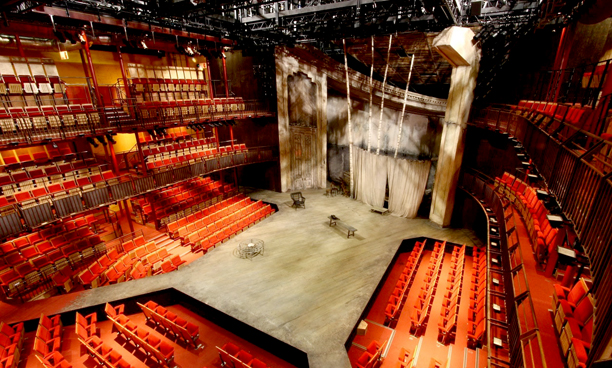
Re-opened in late 2010, the Royal Shakespeare Company ventured into new territory with a Bollywood-style Much Ado About Nothing and its own hit West End and Broadway musical, Matilda.
The move followed extensive re-modelling of the main Royal Shakespeare Theatre (RST) auditorium and smaller adjacent Swan Theatre, accompanied by a substantial and ongoing investment in new production technologies. Part of audio infrastructure developemt is TiMax2 SoundHub matrix…
Immediately prior to the re-build, the nearby Courtyard Theatre was created as a temporary home for the RSC’s productions. It is also the prototype for the new one-room theatre format proposed for the RST and Swan to create a more traditional Shakespearean performance area, characterised by a deep thrust stage surrounded by audience on three sides.
The 48x48 TiMax2 SoundHub matrix with Madi option was chosed to route Madi signals to and from the theatre’s DiGiCo SD9 mixing desk, and also to provide onward signal distribution to what the RSC describes as a three-dimensional delay system. This comprises multiple Meyer Sound UPM-1P balcony delays, UPJ-1Ps on either side of the proscenium and a central UPM-1 cluster above the thrust stage. As well as signal distribution and speaker system management, another requirement for the sound department was flexible delay-matrix processing to apply variable upstage/downstage vocal localisations and band imaging. Other generic DSP platforms that were considered required relatively complex systems of several units to achieve the same end.
‘We were initially going to go with gear our crew are all familiar with, to avoid them having to learn a new bit of software,’ says Head of Sound, Jeremy Dunn. ‘But it was always going to be a bit of a science project involving a number of separate boxes and interfaces feeding into each other’
Dunn was introduced to TiMax SoundHub by HD Pro Audio’s Andy Huffer, who visited with Dave Haydon from TiMax developer Out Board to demo the unit and in particular to convince him that its ‘task-based’ Mac/PC software was simple and intuitive enough that there was really nothing to learn. ‘The big attraction was TiMax SoundHub could give us Madi, analogue and AES I/O, plus DSP all in one box’ Dunn says.
After about an hour’s tuition from Haydon, RSC engineers were programming and auditioning TiMax image definition delay-matrix setups for the different stage zones – applying linked EQ adjustments and assigning Group zone controls to tune and trim the multichannel distributed Courtyard Theatre sound system. As most shows currently have fewer than four or five vocal mics, the operators use aux sends on the SD9 to crossfade individual mics between TiMax inputs which are statically routed to level/delay image definitions programmed to ensure that each actor’s voice is always precedent to any of the loudspeakers whenever they enter that localisation zone.
‘We tried it for about a month, it was a joy to use, sounded great and the price was right so we asked Andy Huffer to get us one’ Dunn reports.
The TiMax SoundHub-S48 unit was first used in the Courtyard Theatre – which expanded from its temporary role into an overflow venue during festival seasons, and which is now mooted as a potential new studio-style home for the RSC’s more experimental and contemporary productions. The TiMax has also since done service in the West End for the RSC’s Much Ado About Nothing at the Noel Coward Theatre, and Jeremy Dunn sees other units possibly being required for future roll-outs of their temporary auditoriums which regularly take up residence in London’s Roundhouse and venues in New York.
The Courtyard hook-up exploits the ‘hub’ capabilities of the system. The RSC TiMax SoundHub unit comprises 32 analogue and 16 AES analogue inputs, with 48 analogue outputs and 16 AES outputs. The built-in Madi interface takes vocal mic direct outs, mix buses and aux sends from the SD9 as inputs to TiMax; then Madi out from the TiMax goes via an RME Madi card into a Mac Powerbook, allowing mic signals to be sent via TiMax to Altiverb reverb plug-ins hosted by Plogue Bidule on the Mac. Madi out of the Mac goes back to the desk to deliver Altiverb reverb returns and QLab sound effects to the console.
Once the reverb returns, vocals, band and sound effects have been re-assembled back at the SD9, its Madi link to the TiMax SoundHub then routes everything to respective parts of the PA system via the SoundHub’s delay matrix and analogue I/O. If AES digital outputs are required in the future, TiMax can provide these at different sample rates (48/96kHz) on any AES output pair, each with independant clock source selectable from internal 48kHz or 96kHz, external WordClock BNC, or from any AES input pair.
Dunn has also shown interest in TiMax Tracker performer tracking automation, taking time out to experience it first-hand at Raymond Gubbay’s Royal Albert Hall in-the-round production of Carmen: ‘I’d always assumed there’d be phasing artifacts unless a real person was judging and managing the transitions, but in Carmen you really couldn’t hear the join, so I’m definitely looking into opportunities to use it at the RSC,’ he says. ‘We’re also interested to start trying out the SoundHub’s playback capabilities for effects – even though its generally all QLab here, TiMax offers an alternative workflow for certain things and some powerful features like editable delay panning; also Dave Haydon has explained how these can be seamlessly integrated with QLab using Midi.’
See also:
Magic Moments at Shakespeare's Globe












